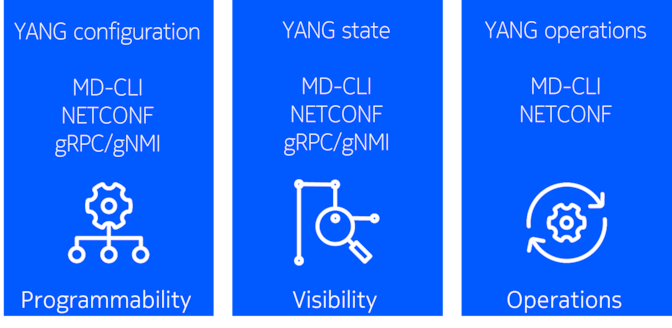Model-driven management
Find out how model-driven interfaces and YANG models enable network programmability, boost operational efficiency and reduce automation costs

Fast-growing demand for 5G and cloud services means that network operators are managing more elements than ever before. Like many, you may be innovating with NetOps and network programmability to simplify and automate network management. By using proven model-driven management approaches to manage your network elements, you can unleash the power of network programmability to increase operational efficiency and reduce costs.
What is model-driven management?
Model-driven management is the use of data models to define the structure, configuration and behavior of different network elements. It lets you add new network elements and make them hot pluggable by integrating corresponding resource models. There is no need to modify management software.
Model-driven management reduces the cost of automating network equipment management tasks by simplifying integration across multiple vendors, products and releases. It also makes network monitoring more responsive, which helps you shorten mean time to recovery (MTTR) and speed up time to revenue.
What can model-driven management do for you?
A model-driven management approach reduces the complexity involved in integrating multivendor network elements, each with their own command line interfaces (CLIs), into management systems. Operators have traditionally needed to create complex adapters to translate between management systems and vendor-specific CLIs. This approach is cumbersome and error prone. It also takes significant time and effort to adapt to software releases for new equipment because CLIs can behave inconsistently and break previous integrations.
Model-driven network management helps you overcome these challenges by simplifying network operations, improving efficiency and bringing greater agility to network service deployment and management.
Why deploy model-driven management now?
Model-driven management provides an easy way to take advantage of the network programmability and automation benefits right away, as you accelerate innovation and simplify network transformation.
Model-driven interfaces for managing network elements have been in development for more than a decade. The technology is mature and provides a wide range of commercial and open-source tools to help you make a smooth and cost-effective transition to model-driven approaches.
Many operators recognize that model-driven management solutions can generate a significant return on investment (ROI) and directly improve the end user quality of experience. Model-driven management enables a modular approach that lets you automate systems at your own pace, so you can achieve immediate efficiencies and cost savings.
What are YANG models?
YANG is a widely used data modeling language that enables you to create consistent, rule-based behavior that is easy to adapt and integrate. Data models created with YANG make it possible for network devices to be configured, provide state information and perform operational activities using network-programmable interfaces. These model-driven interfaces use protocols such as the Network Configuration (NETCONF) protocol, gRPC Remote Procedure Call (gRPC), and the model-driven CLI (MD-CLI).
Network automation based on YANG models

- YANG configuration: Programmability allows humans and machines to configure network elements by using programmatic interfaces to access structured data based on YANG models.
- YANG state: Visibility provides statistics and state information and uses network telemetry to push operational data to northbound management systems.
- YANG operations: Operations provides the ability to consistently manage network devices in automated network environments using programmatic interfaces.
What are the benefits of model-driven management?
Flexible programmability
Quickly and easily introduce new features and network elements into networks that are more dynamic and programmable.
Improved resiliency
Increase network resiliency and reduce manual intervention with consistent rule-based behavior.
Consistency
Simplify network transformation and speed innovation with standardized YANG-based programmatic interfaces that ensure the same look and feel across management interfaces.
Lower cost
Use YANG models to reduce the cost of automating the management of network equipment and the effort required to integrate hardware.
Increased efficiency
Improve operational efficiency and reduce errors by aligning the management interface to device functionality with a common human- and machine-readable configuration and state syntax.
Enhanced visibility and control
Use network telemetry to optimize automation where changes occur quickly and frequently and are streamed to network controllers.
Multivendor integration
Enable seamless mediation into a single multivendor, multi-technology automation platform, an essential capability for network automation on a massive scale.
Simple OSS integration
Decouple the OSS from the network by allowing the automation platform to abstract the device's native functionality or configuration model.
How can Nokia help you embrace model-driven management?
Nokia provides flexible solutions that can help your NetOps team implement model-driven management approaches for IP routing and data center networks.
IP routing
Both of our IP routing operating systems, Nokia SR OS and Nokia SR Linux, include industry-leading model-driven management solutions. The model-driven management capabilities of SR OS and the open, modular architecture of SR Linux support configuration and state management through YANG-based CLI, the NETCONF protocol, and gRPC and gNMI interfaces. They enable streaming telemetry through gRPC and gNMI subscriptions and support operations through a YANG-based CLI and NETCONF protocol.
SR OS and SR Linux support the Nokia Network Services Platform (NSP) through the northbound, model-driven REST interface. NSP provides a model-driven mediation software development kit and supports protocols such as NETCONF protocol and gNMI in combination with YANG-defined data models. You can use these capabilities to integrate Nokia and multivendor equipment across the network, to automate operations from end to end, and to reduce time to market and operational costs.
We have built model-driven interface support into our IP routing portfolio, including the 7750 SR-s Service Router, 7730 Service Interconnect Router (SXR) and 7250 Interconnect Router (IXR). With the comprehensive model-driven management capabilities of our IP routing portfolio, you can enable simplified, automated and cost-optimized network operations.
Data center networks
SR Linux is a truly open network operating system (NOS) that makes data center switching infrastructure more scalable, more flexible and simpler to operate. SR Linux opens the NOS infrastructure with a unique architecture built using model-driven management and modern interfaces. This approach simplifies operations and integrations while giving you the ultimate visibility and flexibility across your network.
Data center hardware platforms running SR Linux include the 7220 IXR-D series Interconnect Routers, 7220 IXR-H series Interconnect Routers and the 7250 IXR-6e/IXR-10e Interconnect Routers.
The Nokia Fabric Services System also simplifies data center network operations. By using intent-based approaches, you can program and implement network automation tasks at scale for each phase of your data center fabric operations, from Day 0 design to Day 1 deployment and Day 2+ operations.
The Nokia Network Developer Portal
The Nokia Developer Portal is designed to help developers transform operational practices and integrate network devices into their own infrastructure. It provides tips, examples, tutorials and labs to help developers use our tools and third-party open-source tools to integrate with the Nokia products that run many of today's global networks.
Related solutions and products
Solution
Open and disaggregated platforms, open model-driven interfaces and open management and control
Product
Build reliable management network solutions for data centers.
Product
Build open and automated data center fabrics with high-capacity, fixed-configuration platforms.
Product
Deploy high-density, high-capacity data center switches for an open, leaf-spine architecture.
Learn more
Video
Signetbreedband evolve business services in the Netherlands
Contact us
To learn how we can help you take advantage of the benefits of model-driven network management, get in touch with a Nokia expert.
Please complete the form below.
The form is loading, please wait...
Thank you. We have received your inquiry. Please continue browsing.















